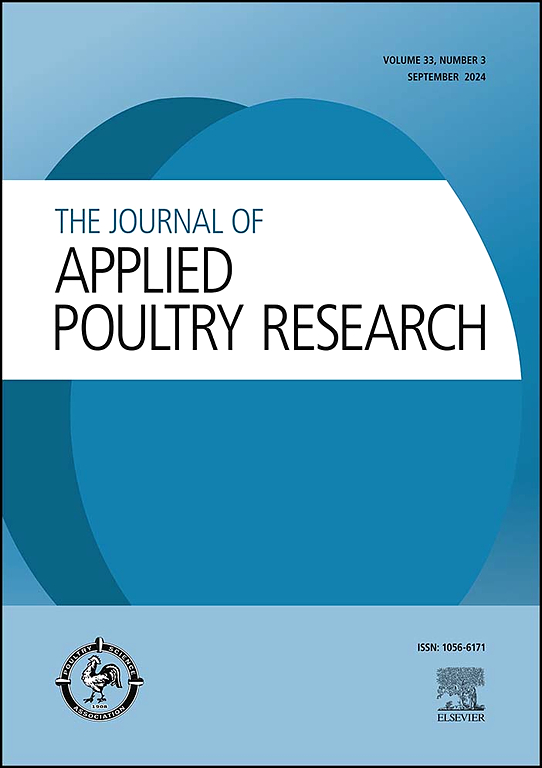Effects of methionine supplement sources and crude protein on Ross 708 male broiler performance and carcass yield
IF 1.6
3区 农林科学
Q2 AGRICULTURE, DAIRY & ANIMAL SCIENCE
引用次数: 0
Abstract
This 42 d experiment investigated the influence of crude protein (CP) levels, methionine (Met) supplement sources, and their interaction on growth performance, processing measurements, footpad lesion scores (FLS), and litter moisture. A total of 3,072 Ross 708 by-product males received diets varying in CP (Standard [SCP] or Reduced 2% [RCP]) and Met sources (None, Methionine hydroxy analog [MHA], or 65% DL-Met [65DLM]). Treatments were arranged in a 2 (CP) x 3 (Met sources) factorial in a randomized complete block design. Each treatment was fed to 16 replicate floor pens with 32 birds/pen across a 3-phase (starter, d 1–10; grower, d 11–24; finisher, d 25–42) feeding program. Performance was measured during d 1 to 10, 1 to 24, and 1 to 42. On d 24 and 42, litter moisture was determined, and 3 birds/pen were selected for FLS. On d 42, 3 birds were selected for processing. Regardless of Met source, RCP-fed birds showed reduced performance compared to birds fed SCP treatments. Birds fed SCP diets increased litter moisture when compared to birds fed RCP diets. Likewise, birds fed either MHA or 65DLM had higher litter moisture content than birds provided a diet with no Met supplementation. On d 42, 90% of FLS across all treatments had a score of “0”. Breast weight was highest when 65DLM was in SCP diets and reduced when MHA was in either RCP or SCP diets. This experiment indicates that 65DLM and MHA can be used interchangeably in formulation, achieving similar performance and improved breast weight with 65DLM in SCP diets.
蛋氨酸补充源和粗蛋白对罗斯 708 公肉鸡性能和胴体产量的影响
这项为期 42 天的实验研究了粗蛋白(CP)水平、蛋氨酸(Met)补充源及其相互作用对生长性能、加工测定、脚垫病变评分(FLS)和窝内水分的影响。共有 3,072 Ross 708 头副产品雄鸡接受了不同 CP(标准 [SCP] 或还原 2% [RCP])和蛋氨酸来源(无、蛋氨酸羟基类似物 [MHA] 或 65% DL-Met [65DLM])的日粮。处理采用 2(CP)x 3(Met 来源)阶乘随机完全区组设计。每种处理饲喂 16 个重复的底栏,每栏 32 只鸡,饲喂程序分为 3 个阶段(开食期,第 1-10 天;生长期,第 11-24 天;育成期,第 25-42 天)。分别在第 1-10 天、第 1-24 天和第 1-42 天测量其生产性能。第 24 天和第 42 天,测定窝的湿度,每栏选 3 只鸡进行 FLS。第 42 天,每栏选 3 只进行处理。与饲喂 SCP 的家禽相比,无论 Met 来源如何,饲喂 RCP 的家禽的生产性能都有所下降。与饲喂 RCP 日粮的家禽相比,饲喂 SCP 日粮的家禽粪便水分增加。同样,饲喂 MHA 或 65DLM 的鸟类比饲喂未补充 Met 的鸟类有更高的粪便水分含量。在第 42 天,所有处理中 90% 的 FLS 得分为 "0"。在 SCP 日粮中添加 65DLM 时,胸重最高,而在 RCP 或 SCP 日粮中添加 MHA 时,胸重降低。该实验表明,65DLM 和 MHA 可在配方中交替使用,在 SCP 日粮中添加 65DLM 可获得相似的性能和更高的胸重。
本文章由计算机程序翻译,如有差异,请以英文原文为准。
求助全文
约1分钟内获得全文
求助全文
来源期刊

Journal of Applied Poultry Research
农林科学-奶制品与动物科学
CiteScore
4.10
自引率
10.50%
发文量
80
审稿时长
104 days
期刊介绍:
The Journal of Applied Poultry Research (JAPR) publishes original research reports, field reports, and reviews on breeding, hatching, health and disease, layer management, meat bird processing and products, meat bird management, microbiology, food safety, nutrition, environment, sanitation, welfare, and economics. As of January 2020, JAPR will become an Open Access journal with no subscription charges, meaning authors who publish here can make their research immediately, permanently, and freely accessible worldwide while retaining copyright to their work. Papers submitted for publication after October 1, 2019 will be published as Open Access papers.
The readers of JAPR are in education, extension, industry, and government, including research, teaching, administration, veterinary medicine, management, production, quality assurance, product development, and technical services. Nutritionists, breeder flock supervisors, production managers, microbiologists, laboratory personnel, food safety and sanitation managers, poultry processing managers, feed manufacturers, and egg producers use JAPR to keep up with current applied poultry research.
 求助内容:
求助内容: 应助结果提醒方式:
应助结果提醒方式:


